Cite this document
(“Middle Earth-from the novel to the silver screen Research Paper”, n.d.)
Retrieved from https://studentshare.org/visual-arts-film-studies/1462838-middle-earth-from-the-novel-to-the-silver-screen
Retrieved from https://studentshare.org/visual-arts-film-studies/1462838-middle-earth-from-the-novel-to-the-silver-screen
(Middle Earth-from the Novel to the Silver Screen Research Paper)
https://studentshare.org/visual-arts-film-studies/1462838-middle-earth-from-the-novel-to-the-silver-screen.
https://studentshare.org/visual-arts-film-studies/1462838-middle-earth-from-the-novel-to-the-silver-screen.
“Middle Earth-from the Novel to the Silver Screen Research Paper”, n.d. https://studentshare.org/visual-arts-film-studies/1462838-middle-earth-from-the-novel-to-the-silver-screen.


